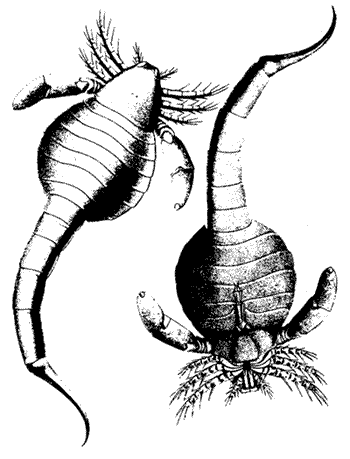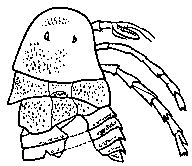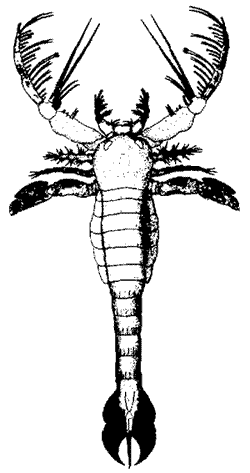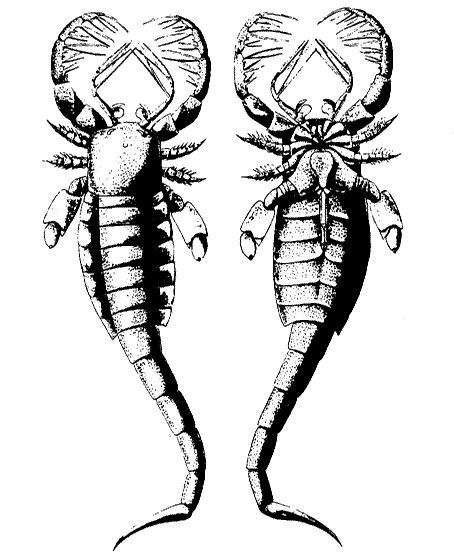Superfamily Mixopteracea

Mixopterus kiaeri - walking posture
Introduction
Carcinosomatidae
Mycteropidae
Megalograptidae
Mixopteridae
Links
The most scorpion-like of the Eurypterids (and possibly ancestral to the scorpions), this is a diverse group of often spiny Eurypterids. Many of these animals were clearly amphibious, as is indicated by a trail in the Silurian of Ringerike, Norway, believed to have been made by a large Mixopterus.

Carcinosoma scorpionis (Grote and Pitt)
length to half a meter
Late Silurian (Ludlow) of New York (west-central Euramerica)
illustration from Treatise on Invertebrate Paleontology
Carcinosoma (above) has a large discoidal pre-abdomen with a marked waist and
a cylindrical post-abdomen and, like the
fearsome-looking Mixopterus, it has a telson, like that of a scorpion, apparently modified as a poison spine.
family Carcinosomatidae
 Family Carcinosomatidae Størmer 1934
Family Carcinosomatidae Størmer 1934
time range: Floian to Emsian - ? Frasnian
known distribution: Euramerica
habitat: Marginal marine
representative taxa: Carcinosoma scorpionis average length about
30 cm; the larger Carcinosoma grandis was 60 to 90 cm lo Both from the late Silurian Waterlime of North Buffalo, New York. Eocarcinosoma ruedemanni from the Middle Ordovician of New York state is the earliest species.
description: Small to large forms with scattered minute tubercles or raised tongue-shaped scales. The prosoma is subtriangular in shape, with small compound eyes small and located toward the side of the head. The fore part of the abdomen is widened to form a distinct mesosoma, while the postabdomen is narrow and cylindrical with a curved telson, giving the whole body a rather scorpion-like appearance. The chelicerae are small, the walking legs have long spines, with the second pair of legs the longest. The metastoma is subtriangular;
genital appendage probably short and broad in type "B" form, long with distal spines in type "A" form. Carcinosoma was originally known as Eusarcus.

Mycterops? scabrosus
width about 70 cm
Early Carboniferous, Scotland (central Euramerica)
illustration from Treatise on Invertebrate Paleontology
family Mycteropidae
 Family Mycteropidae Størmer, 1951
Family Mycteropidae Størmer, 1951
time range: Serpukhovian to Moscovian
known distribution: Euramerica
habitat: Fresh water - amphibious
description: Medium to fairly large forms; outer surface decorated with numerous scales and reticulate (cross-hatched) ornamentation; the prosoma subtrapezoid, with the fist and possibly the second tergite of abdomen strongly developed and deep. The legs are of the stylonurid type.

Megalograptus ohioensis
body length about a meter
Hirnantian epoch of Ohio (Laurentia)
illustration from Treatise on Invertebrate Paleontology
family Megalograptidae
 Family Megalograptidae Caster & Kjellesvig-Waeritag, 1955
Family Megalograptidae Caster & Kjellesvig-Waeritag, 1955
time range: ?Sandbian to
Hirnantian
known distribution: Laurentia
habitat: Marine to marginal marine
representative taxa: Echinognathus is a large form with appendages armed with curved spines,
?Sandbian of New York; Megalograptus from the Richmond series (Latest Ordovician -
Hirnantian) of Ohio is another genus. As the name indicates, its fragmentary remains seem to have been originally described as from a graptolite!
description: huge spectacular spiny predatory Ordovician forms, clearly active hunters, seem to have taken over from the waning
Endocerid nautiloids as the superpredators of the late Ordovician oceans. Nevertheless they were a short-lived group, geographically restricted, and seem to have been wiped out by the terminal Ordovician mass
extinction, although not before giving rise to the Mixopteridae. The compound eyes face forward, and there
tongue-like extension at the front of the prosoma bearing large marginal spines. The chelicerae small and short, 1st and 3rd walking legs relatively short, with closely set spines, second pair of legs enormously developed, with long paired spines for snaring prey. The preabdomen narrow with axial furrows; the postabdomen moderately narrow; telson narrow lanceolate, with what seem to be side claspers. The epistoma short and broad; metastoma subovate to cordate;
genital appendage of type "B" form club-shaped, of type "A" form short and narrow.

Mixopterus kiaeri Størmer
dorsal and ventral view
body length about 75 cm
Pridoli or early Lokhovian of Norway (north-east Euramerica
illustration from Treatise on Invertebrate Paleontology
family Mixopteridae
 Family Mixopteridae Caster & Kjellesvig Waering, 1955
Family Mixopteridae Caster & Kjellesvig Waering, 1955
time range: Wenlock to Pridoli
known distribution: Euramerica
habitat: Marginal marine to ?brackish - amphibious
description: Large scorpion-like forms, exoskeleton with scattered tubercles
or semicircular scales, prosoma squarish (subquadrate) preabdomen fairly narrow, with axial furrows; postabdomen narrow, with a curved telson, possibly bearing a poison sting. First two pairs of legs strongly developed, with paired spines. These were held out in front of the animal to catch prey. Third and fourth pairs of moderate in size, with short spines, used for walking. Metastoma narrow cordate;
genital appendage of type "A" form long. It has been suggested that these animals were ancestral to Scorpions, although the two groups probably diverged fairly early.
Links


 Faktablad om sjøskorpioner - this site is in Norwegian, it includes a photo of a superb Mixopterus specimen
Faktablad om sjøskorpioner - this site is in Norwegian, it includes a photo of a superb Mixopterus specimen
 Eurypterida
- nice reconstruction of a Mixopteris here
Eurypterida
- nice reconstruction of a Mixopteris here
images not loading? | error messages? | broken links? | suggestions? | criticism?
page uploaded 12 June 2002
checked ATW040206
(originally uploaded on Kheper Site 3 October 2000)
text by
M. Alan Kazlev Creative Commons Attribution 2000-2002
bars and buttons from
Jelane's families of graphics




 Family Carcinosomatidae Størmer 1934
Family Carcinosomatidae Størmer 1934

 Family Mycteropidae Størmer, 1951
Family Mycteropidae Størmer, 1951

 Family Megalograptidae Caster & Kjellesvig-Waeritag, 1955
Family Megalograptidae Caster & Kjellesvig-Waeritag, 1955

 Family Mixopteridae Caster & Kjellesvig Waering, 1955
Family Mixopteridae Caster & Kjellesvig Waering, 1955
![]()
![]()
![]() Faktablad om sjøskorpioner - this site is in Norwegian, it includes a photo of a superb Mixopterus specimen
Faktablad om sjøskorpioner - this site is in Norwegian, it includes a photo of a superb Mixopterus specimen![]() Eurypterida
- nice reconstruction of a Mixopteris here
Eurypterida
- nice reconstruction of a Mixopteris here